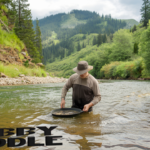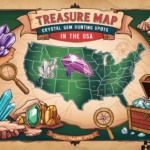Virginia, known for its rich history and natural beauty, harbors another treasure beneath its soil and streams – gold. The practice of gold panning in Virginia has captivated prospectors and adventure seekers for centuries, offering a unique blend of outdoor recreation and the thrill of potentially striking it rich.
This comprehensive guide will delve deep into the world of gold prospecting in Virginia, exploring its history, best locations, techniques, and everything you need to know to embark on your own golden adventure in 2024.
The Glittering Past: Virginia’s Golden Legacy
From Colonial Dreams to Modern-Day Streams
Long before the famous California Gold Rush, Virginia was making waves in the world of gold mining. The first documented gold discovery in the United States occurred in 1782 at the Whitehall Mine in Spotsylvania County, Virginia. This find sparked interest in the region’s mineral wealth and set the stage for a fascinating chapter in American history.
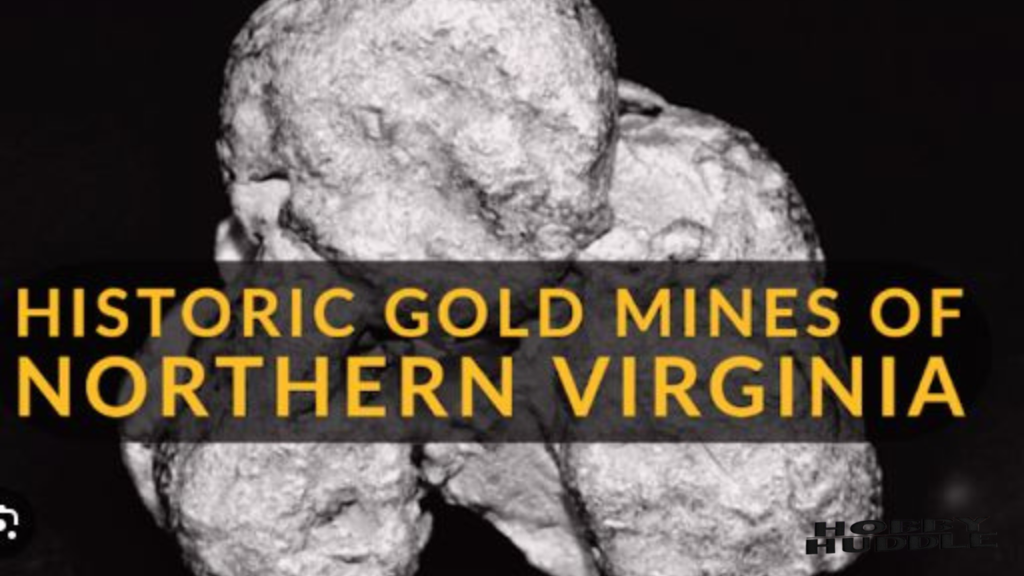
The Virginia gold rush began in earnest in the early 19th century, with prospectors flocking to the state in hopes of striking it rich. While not as well-known as its California counterpart, Virginia’s gold rush played a significant role in shaping the state’s economy and development during this period.
Gold mining in Virginia reached its peak between 1830 and 1850, with numerous mines operating throughout the gold-pyrite belt. This geological formation stretches from Fairfax County in the north to Appomattox County in the south, covering a distance of about 140 miles. The belt varies in width from 10 to 35 miles, creating a vast playground for modern-day prospectors.
You Might Like This: Rockhounding in Washington [The Ultimate Guide for 2024]
Virginia’s Own Gold Rush: When and Where?
The Virginia gold rush kicked off in earnest around 1829, following a series of significant discoveries. One of the most notable early finds was made by a farmer named John Moss, who stumbled upon a 17-pound gold nugget on his property in Goochland County. This discovery, along with others in nearby counties, triggered a wave of gold fever that swept across the state.
The gold-bearing regions of Virginia primarily concentrated in the following counties:
- Spotsylvania
- Orange
- Louisa
- Fluvanna
- Goochland
- Buckingham
- Culpeper
- Fauquier
These areas saw a flurry of activity, with prospectors panning creeks and rivers, and miners digging shafts and tunnels in search of gold-bearing quartz veins. Small towns and mining camps sprang up overnight, transforming the landscape and economy of central Virginia.
How Virginia’s Gold Shaped the California Gold Rush
While Virginia’s gold rush may have been overshadowed by the later California Gold Rush, it played a crucial role in setting the stage for that monumental event. Many of the techniques and technologies developed in Virginia’s gold fields were later applied in California, giving Virginia miners a significant advantage when they headed west.
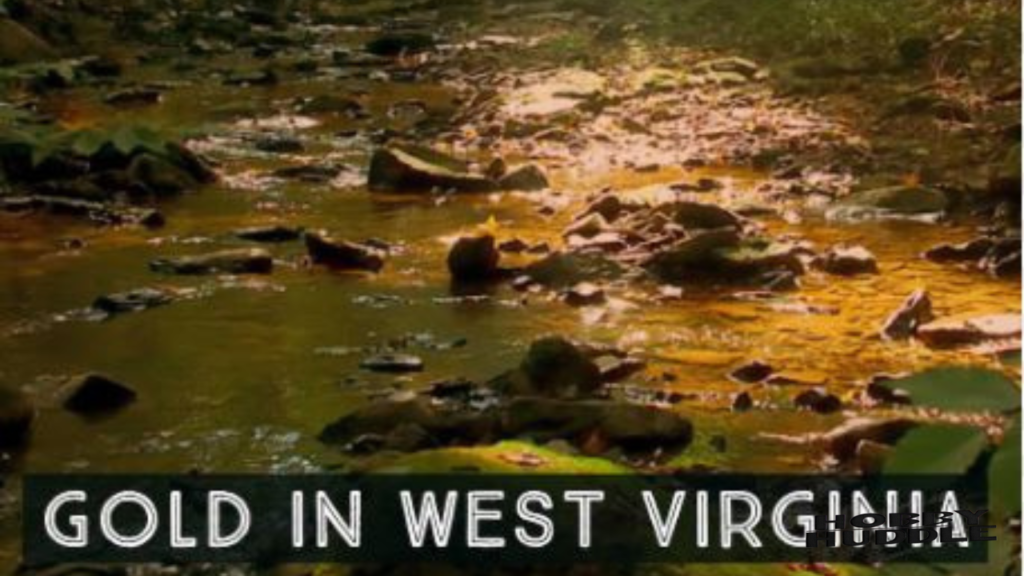
Moreover, the experience gained in Virginia’s mines proved invaluable when gold was discovered at Sutter’s Mill in 1848. Many Virginian miners, already skilled in prospecting and extraction techniques, were among the first to arrive in California, often finding success where others struggled.
This connection between the two gold rushes highlights Virginia’s important place in the broader narrative of American gold mining history. It’s a legacy that continues to attract prospectors to the state’s streams and hillsides to this day.
You Might Like This: Gold Panning in Pennsylvania [A Gold Prospecting Guide for 2024]
Golden Geography: Virginia’s Aurous Hotspots
The Virginia Gold-Pyrite Belt: Nature’s Vault
The Virginia Gold-Pyrite Belt is a geological formation that has been the source of most of the state’s gold production. This belt, stretching diagonally across the state, is characterized by its unique mineralogy and rock formations that are conducive to gold deposits.
The belt was formed millions of years ago through intense geological processes. Volcanic and sedimentary rocks were subjected to high pressures and temperatures, causing them to metamorphose and creating conditions ideal for gold mineralization. The gold in this region is often found in quartz veins or as placer deposits in streams and rivers that have eroded these gold-bearing rocks over time.
Understanding the geology of the Gold-Pyrite Belt is crucial for modern prospectors. The belt is not uniformly rich in gold; rather, it contains pockets of high concentration interspersed with areas of lower yield. Successful prospectors often combine knowledge of geology with traditional panning techniques to maximize their chances of finding gold.
Major Gold Discoveries That Put Virginia on the Map
Virginia’s gold mining history is punctuated by several significant discoveries that fueled the gold rush and put the state on the map as a gold-producing region. Here are some of the most notable finds:

- The Whitehall Discovery (1782): The first documented gold discovery in the United States, found in Spotsylvania County.
- The Moss Nugget (1829): A 17-pound gold nugget found by John Moss in Goochland County, which helped trigger the Virginia gold rush.
- The Franklin Mine: Located in Fauquier County, this was one of the most productive mines in Virginia, yielding over 5,000 ounces of gold.
- The Vaucluse Mine: Situated in Orange County, this mine was notable for its deep shaft (over 400 feet) and advanced technology for its time.
- The Tellurium Mine: Located in Goochland County, this mine was known for producing some of the purest gold in the state.
These discoveries not only spurred further exploration but also contributed to the development of mining techniques and technology that would later be applied across the country.
Current Production: Is Virginia Still a Golden State?
While Virginia’s gold production has significantly decreased since its 19th-century heyday, the state still holds potential for both commercial mining and recreational prospecting. As of 2024, there are no large-scale commercial gold mining operations in Virginia. However, this doesn’t mean the gold has run out – rather, it reflects changes in mining economics and environmental regulations.
For recreational prospectors and small-scale miners, Virginia continues to offer opportunities. Many of the historic gold-bearing areas still yield gold, particularly for those willing to put in the effort with panning and sluicing techniques. The state’s Department of Mines, Minerals and Energy estimates that significant gold reserves may still exist in Virginia, particularly in areas that were overlooked or under-explored during the original gold rush.
It’s worth noting that modern prospecting in Virginia is as much about the experience and connection to history as it is about striking it rich. Many enthusiasts find satisfaction in recovering even small amounts of gold, viewing it as a tangible link to the state’s fascinating mining heritage.
You Might Like This: Dumpster Diving In Indiana [Is It Legal in 2024?]
Striking Gold: A Modern Prospector’s Guide
Essential Tools of the Trade
To embark on your gold panning adventure in Virginia, you’ll need the right tools. Here’s a comprehensive list of equipment that modern prospectors typically use:
| Basic Equipment | Intermediate Tools | Advanced Gear |
|---|---|---|
| Gold Pan | Sluice Box | Metal Detector |
| Classifier | Snuffer Bottle | High-banker |
| Shovel | Tweezers | Dredge |
| Bucket | Vial or Container | Gold Cube |
| Rubber Boots | Magnet | Blue Bowl |
| Gloves | Crevice Tool | Prospecting Pump |
| Sunscreen | Gold Scoop | Smelting Kit |
| Hat | Hand Lens | XRF Analyzer |
From Pans to Sluices: Choosing Your Weapons
- Gold Pan: The most basic and essential tool for any prospector. Modern pans are typically made of plastic and feature riffles to help trap gold.
- Classifier: A sieve-like tool used to sort material by size before panning, increasing efficiency.
- Sluice Box: A long, narrow channel with riffles that uses flowing water to separate gold from sediment.
- Snuffer Bottle: Used to suck up small gold flakes from your pan.
- High-banker: A powered sluice that can process larger volumes of material.
High-Tech Helpers: Metal Detectors and Beyond
- Metal Detector: Can help locate larger gold nuggets buried in soil or embedded in rock.
- XRF Analyzer: A handheld device that uses X-rays to determine the elemental composition of rocks and minerals.
- Gold Cube: A modern gravity separation device that can process large amounts of material efficiently.
Techniques to Boost Your Odds
Reading the River: Where Gold Likes to Hide
Understanding where gold is likely to accumulate can significantly increase your chances of success. Here are some key areas to focus on:
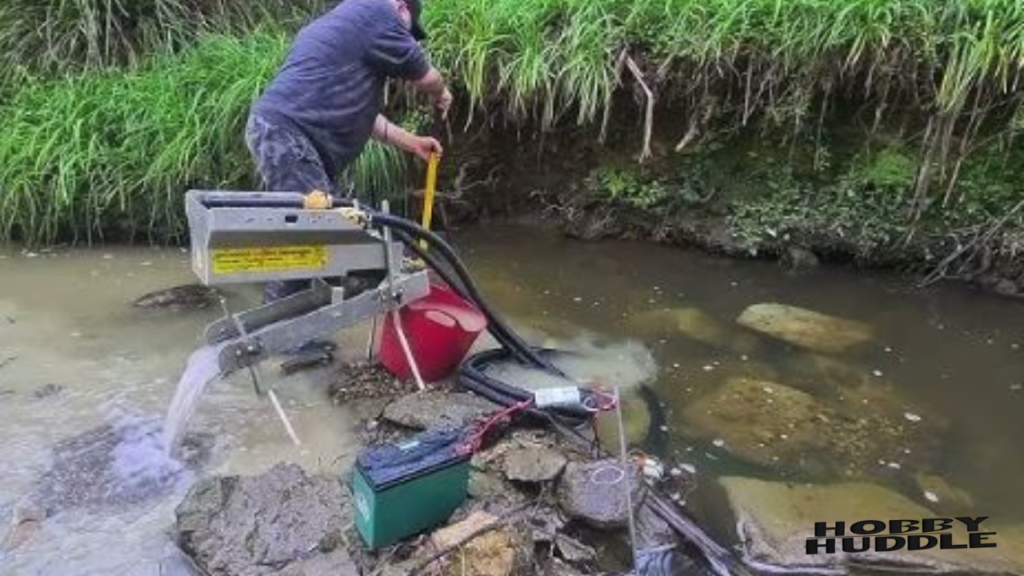
- Inside bends of rivers: Gold, being heavier than most sediments, tends to settle in these slower-moving areas.
- Behind large boulders: These create natural traps for gold as water flows around them.
- Bedrock cracks and crevices: Gold can become lodged in these natural traps over time.
- Gravel bars: Particularly those exposed during low water periods.
- Confluence of streams: Where two streams meet, changes in water flow can cause gold to settle.
The Art of the Swirl: Perfecting Your Pan
Mastering the technique of gold panning takes practice, but here are the basic steps:
- Fill your pan about 2/3 full with classified material.
- Submerge the pan in water, tilting it slightly away from you.
- Use a circular motion to swirl the material, allowing lighter sediments to wash away.
- Tilt the pan forward slightly and use a gentle back-and-forth motion to reveal any gold at the leading edge of the pan.
- Repeat the process, gradually removing larger rocks and pebbles.
- As you get down to finer material, look for the characteristic golden glint of gold flakes or nuggets.
Remember, patience and persistence are key. Even experienced prospectors don’t strike gold every time, but the thrill of the search is part of the appeal.
You Might Like This: 1965 Quarter Coin Value (Errors List & No Mint Mark Worth)
Navigating the Golden Rules: Laws and Etiquette
Public vs. Private: Where Can You Legally Pan?
When it comes to gold panning in Virginia, it’s crucial to understand where you can legally prospect. The rules can be complex, but here’s a general overview:
- Public Lands: Some public lands in Virginia allow recreational gold panning. These include certain areas within national forests and some state parks. However, always check with the managing agency before panning, as rules can vary.
- Private Property: You must always obtain permission from the landowner before prospecting on private property. This includes both the land where you’re panning and any land you need to cross to access the panning site.
- Navigable Waterways: In Virginia, the beds of navigable waterways are generally considered state property. However, this doesn’t automatically grant permission to pan for gold. Always check local regulations.
- Historic Sites: Many former gold mining areas are now protected as historic sites. Panning is typically prohibited in these locations to preserve their historical integrity.
Permits and Paperwork: Staying on the Right Side of the Law
While recreational gold panning often doesn’t require a permit in Virginia, there are situations where you might need one:
- Commercial Operations: Any gold panning done for commercial purposes typically requires permits from state and possibly federal agencies.
- Use of Powered Equipment: If you plan to use motorized equipment like dredges or high-bankers, you may need permits from environmental agencies.
- State Parks: Some state parks that allow gold panning may require a permit or have specific rules about equipment use.
- National Forests: While many national forests allow recreational gold panning without a permit, always check with the local ranger district for specific rules.
To ensure you’re in compliance, contact the Virginia Department of Energy, the U.S. Forest Service (for national forest land), or Virginia State Parks (for state park land) before you start prospecting.
Leave No Trace: Responsible Prospecting Practices
Responsible gold panning isn’t just about following the law – it’s also about preserving the environment for future generations of prospectors and outdoor enthusiasts. Here are some key principles to follow:
- Minimize Disturbance: Avoid damaging vegetation or disrupting wildlife habitats. Refill any holes you dig.
- Properly Dispose of Waste: Pack out all trash and dispose of it properly.
- Respect Wildlife: Observe wildlife from a distance and do not feed animals.
- Be Considerate of Other Visitors: Some people may be there to enjoy nature, not to pan for gold. Keep noise levels down and be respectful of others’ space.
- Leave What You Find: Apart from your gold, leave rocks, plants, and other natural objects as you find them.
- Use Environmentally Friendly Methods: Avoid using mercury or other harmful chemicals in your prospecting activities.
By following these guidelines, you help ensure that Virginia’s gold panning sites remain accessible and enjoyable for everyone.
Virginia’s Top 5 Gold Panning Hotspots
Virginia offers numerous locations for gold panning enthusiasts. Here are five of the best spots to try your luck:
The Rappahannock’s Riches
The Rappahannock River, particularly in the areas around Fredericksburg, has been a popular spot for gold panning since the early days of Virginia’s gold rush. The river’s geology and flow patterns make it an excellent location for finding placer gold.
Best Access Points: Kelly’s Ford and Motts Run Reservoir Recreation Area are good starting points for prospecting along the Rappahannock.
What to Expect: Fine gold flakes are common, with occasional small nuggets. The river’s broad floodplain can also yield gold in the soil away from the current water course.
James River: A Golden Highway
The James River, one of Virginia’s major waterways, has a long history of gold production. Its extensive drainage basin covers much of the Virginia Gold-Pyrite Belt, making it a prime location for prospectors.
Best Access Points: The James River State Park and the areas around Columbia and Scottsville are known for their gold panning potential.
What to Expect: Gold in the James River tends to be fine, but patient panners can accumulate a respectable amount over time. Look for areas of slower water flow and natural traps behind large rocks.
Lake Anna State Park: Family-Friendly Prospecting
Lake Anna State Park, located in Spotsylvania County, offers a unique gold panning experience. The park was created by damming the North Anna River, which flows through part of the gold belt.
Best Access Points: The park offers designated areas for gold panning. Check with park rangers for the most up-to-date information on permitted locations.
What to Expect: While not as rich as some river locations, Lake Anna can be a great place for beginners to practice their panning technique. The controlled environment and park facilities make it ideal for family outings.
Rapidan River: Where History Meets Gold
The Rapidan River, a tributary of the Rappahannock, flows through several counties known for their historical gold production. Its relatively undeveloped banks offer a chance to pan in areas that might not have been thoroughly prospected in the past.
Best Access Points: Areas near Culpeper and Orange counties are good places to start. Always ensure you have permission if accessing the river through private property.
What to Expect: The Rapidan can yield both fine gold and occasional small nuggets. Its less-trafficked nature means you might have better luck finding overlooked deposits.
Willis River: An Underrated Gem
The Willis River, located in Buckingham County, is often overlooked by prospectors but has a history of gold production. Its location in the heart of the Virginia Gold-Pyrite Belt makes it a promising spot for modern-day panners.
Best Access Points: The river passes through Cumberland State Forest, which may offer public access points. Always check local regulations before panning.
What to Expect: The Willis River can offer a mix of fine gold and occasional larger pieces. Its less popular status means you might face less competition from other prospectors.
Here’s a table summarizing key information about these top gold panning locations in Virginia:
| Location | Best For | Type of Gold | Accessibility | Facilities |
|---|---|---|---|---|
| Rappahannock River | Experienced panners | Fine flakes, small nuggets | Moderate | Limited |
| James River | All skill levels | Fine gold | Good | Varies by location |
| Lake Anna State Park | Beginners, families | Fine gold | Excellent | Full park facilities |
| Rapidan River | Adventure seekers | Fine gold, small nuggets | Moderate | Limited |
| Willis River | Solitude seekers | Mixed sizes | Challenging | Very limited |
Remember, success in gold panning often comes down to persistence, technique, and a bit of luck. Even if you don’t strike it rich, the experience of connecting with Virginia’s golden history can be rewarding in itself.
Striking it Rich: Success Stories and Notable Finds
Virginia’s Biggest Nuggets: Fact vs. Fiction
- The Moss Nugget: Found in 1829 by John Moss in Goochland County, this 17-pound nugget sparked the Virginia gold rush. While not the largest ever found, its historical significance cannot be overstated.
- The Fisher Nugget: Discovered in 1878 near Richardsville in Culpeper County, this nugget weighed approximately 14 ounces and was one of the largest authenticated finds in Virginia.
- The Whitehall Mine Nuggets: The Whitehall Mine in Spotsylvania County, site of the first documented gold discovery in the United States, produced several notable nuggets in the 1-2 ounce range during its operational years.
It’s important to note that many stories of large nuggets in Virginia are difficult to verify, often blurring the line between fact and local legend. Most gold found in Virginia today tends to be in the form of small flakes or fine gold dust, making any nugget find particularly exciting.
Modern-Day Discoveries: Yes, There’s Still Gold in Them Hills!
While the days of major gold rushes may be behind us, modern prospectors continue to find gold in Virginia’s streams and hills. Here are some recent success stories:
- Lake Anna Gold: In 2018, a recreational prospector reported finding over 3 grams of gold in a single day at Lake Anna State Park, proving that patience and persistence can still pay off.
- Rappahannock Riches: A group of weekend prospectors working a stretch of the Rappahannock River near Fredericksburg in 2020 recovered nearly an ounce of gold over a summer season, mostly in the form of fine flakes and small nuggets.
- James River Jackpot: In 2021, a metal detectorist searching old mine tailings along the James River unearthed a 1.5-ounce gold nugget, one of the largest found in the state in recent years.
- Rapidan Surprise: A novice panner attending a prospecting club outing on the Rapidan River in 2022 found a 3.2-gram nugget on their first day, showcasing that beginners luck is still alive and well in gold panning.
These modern finds demonstrate that while commercial-scale gold mining may no longer be economically viable in Virginia, the thrill of discovery is still very much alive for recreational prospectors.
Beyond the Pan: The Broader Impact of Gold in Virginia
Economic Ripples: Tourism and Local Businesses
The legacy of gold in Virginia continues to have economic impacts beyond the value of the metal itself. Here’s how:
- Geotourism: Many former mining sites have been transformed into tourist attractions, offering guided tours, museum exhibits, and hands-on panning experiences.
- Prospecting Equipment Sales: Local outdoor and prospecting supply stores benefit from selling equipment to both serious prospectors and curious tourists.
- Accommodation and Dining: Areas known for gold panning often see increased visitors, boosting local hotels, campgrounds, and restaurants.
- Prospecting Classes and Tours: Many experienced prospectors offer classes or guided expeditions, creating a niche tourism market.
- Jewelry and Souvenirs: Local artisans often incorporate Virginia gold into unique jewelry pieces, creating high-value souvenirs for tourists.
Here’s a table showing the estimated economic impact of gold-related tourism in Virginia:
| Activity | Estimated Annual Revenue | Jobs Supported |
|---|---|---|
| Gold Panning Tours | $1.2 million | 25-30 |
| Equipment Sales | $800,000 | 10-15 |
| Accommodation | $3.5 million | 50-60 |
| Dining | $2.8 million | 40-50 |
| Souvenirs/Jewelry | $1.5 million | 20-25 |
Environmental Considerations: Balancing Prospecting and Conservation
While modern recreational gold panning has a much smaller environmental footprint than historical mining operations, it’s still crucial to consider the ecological impact:
- Erosion Control: Excessive digging or use of powered equipment can increase erosion along riverbanks. Responsible prospectors take care to minimize disturbance.
- Wildlife Habitats: Many gold-bearing streams are also important habitats for fish and other aquatic life. Prospectors need to be mindful of spawning seasons and protected species.
- Water Quality: While small-scale panning has minimal impact, larger operations or irresponsible practices can affect water clarity and quality.
- Historical Preservation: Many former mining sites are now protected for their historical value, limiting prospecting activities to preserve these areas.
- Reclamation Efforts: Some areas damaged by historical mining practices are undergoing reclamation, a process that can be disrupted by uncontrolled prospecting.
Educational Opportunities: Geology, History, and Hands-On Learning
Gold panning in Virginia offers unique educational opportunities:
- Geological Education: Prospecting provides hands-on experience with geological concepts like mineral formation, erosion, and sediment transport.
- Historical Learning: Gold panning connects participants with Virginia’s mining history, offering insights into the state’s economic development.
- Environmental Science: Responsible prospecting teaches about ecosystem balance and the importance of conservation.
- STEM Skills: Gold panning incorporates elements of science, technology, engineering, and math, making it an excellent outdoor STEM activity.
- Outdoor Skills: Prospectors develop skills in navigation, outdoor safety, and reading natural landscapes.
Many schools and universities in Virginia have incorporated gold panning into their earth science curricula, recognizing its value as an engaging, hands-on learning experience.
FAQ: Nuggets of Wisdom for Virginia Gold Seekers
Addressing common myths and misconceptions
Q: Is all the gold in Virginia already mined out? A: No, while large-scale commercial mining is no longer economically viable, there’s still gold to be found. Erosion continually exposes new deposits, and many areas were never thoroughly prospected.
Q: Do I need expensive equipment to find gold in Virginia? A: Not necessarily. While advanced equipment can help, many successful prospectors use nothing more than a simple gold pan and classifier.
Q: Is it legal to keep gold I find in Virginia? A: Generally, yes, if you’re panning on public land where it’s allowed or on private property with permission. However, always check local regulations as rules can vary.
Q: Can I make a living gold panning in Virginia? A: It’s highly unlikely. Most modern prospecting in Virginia is recreational. The gold found typically doesn’t offset the time and expenses involved.
Expert tips for beginners
- Start with the right location: Research historical gold-producing areas and seek advice from local prospecting clubs.
- Master your technique: Practice your panning technique at home with some sand and a few small lead weights to simulate gold.
- Be patient: Gold panning takes time and persistence. Don’t get discouraged if you don’t find gold immediately.
- Respect the environment: Always follow Leave No Trace principles and local regulations.
- Join a club: Local prospecting clubs can provide valuable knowledge, group outings, and sometimes access to private lands.
Resources for further learning and community engagement
- Virginia Department of Energy: Offers information on geology and mineral resources in the state.
- Gold Prospectors Association of America (GPAA): National organization with local chapters in Virginia.
- Virginia Gold Prospecting: Online forum for Virginia prospectors to share tips and locations.
- U.S. Forest Service: Provides information on regulations for prospecting in national forests.
- Virginia State Parks: Some state parks offer gold panning programs and can provide information on where panning is allowed.
The Future of Gold Panning in Virginia
Emerging technologies in amateur prospecting
As technology advances, new tools are becoming available to amateur prospectors:
- Portable XRF Analyzers: These devices can quickly analyze the elemental composition of rocks and sediments, helping prospectors identify promising areas.
- Drone Mapping: Some prospectors are using drones to create detailed maps of potential panning sites, identifying promising features from the air.
- AI-assisted Metal Detectors: New metal detectors use artificial intelligence to better differentiate between gold and other metals, increasing efficiency.
- Augmented Reality Apps: Some apps overlay geological data onto real-world views, helping prospectors understand the terrain they’re working in.
- Lightweight, Portable Power Sluices: Advances in battery technology are making powered equipment more accessible for remote locations.
Potential new areas for exploration
While much of Virginia has been prospected over the years, there’s still potential for new discoveries:
- Re-examining Old Tailings: Modern techniques can often extract gold from the waste material left by less efficient historical mining operations.
- Deep Placer Deposits: Some geologists believe there may be untapped deep placer deposits in Virginia that were beyond the reach of historical mining techniques.
- Urban Prospecting: As cities expand, construction sometimes exposes gold-bearing layers, leading to urban prospecting opportunities.
- Submarine Prospecting: While not currently practiced in Virginia, advances in technology could potentially open up offshore areas for exploration in the future.
Sustainability and preservation efforts
As interest in recreational gold panning continues, efforts are being made to ensure its long-term sustainability:
- Education Programs: Many parks and prospecting clubs are increasing their educational efforts to ensure new prospectors understand responsible practices.
- Rotating Panning Areas: Some public lands are experimenting with rotating permitted panning areas to allow heavily used spots to recover.
- Restoration Projects: There are ongoing efforts to restore areas damaged by historical mining while still allowing for recreational prospecting.
- Citizen Science: Some organizations are enlisting recreational prospectors to help collect data on stream health and mineral distributions.
- Virtual Panning Experiences: To reduce impact on popular sites, some parks are exploring virtual or augmented reality gold panning experiences.
Here’s a table summarizing some of the sustainability efforts in Virginia’s gold panning community:
| Initiative | Description | Impact |
|---|---|---|
| Education Programs | Workshops on responsible panning | Reduced environmental impact |
| Rotating Panning Areas | Periodic closure of popular sites | Improved stream recovery |
| Restoration Projects | Replanting and erosion control | Enhanced ecosystem health |
| Citizen Science | Data collection by prospectors | Improved understanding of resources |
| Virtual Experiences | AR/VR panning simulations | Reduced pressure on physical sites |
As we look to the future, the goal is to balance the thrill of gold panning with the need to preserve Virginia’s natural and historical resources. With responsible practices and ongoing education, gold panning can continue to be a rewarding pursuit for generations to come, connecting modern-day adventurers with the rich golden history of the Old Dominion.

Emma Garcia is a seasoned blogger at Hobby Huddle, where her passion for exploring diverse hobbies shines through her engaging posts. With years of experience in writing and a keen eye for detail, Emma brings readers insightful tips and fresh perspectives on everything from crafts to cooking. Her enthusiasm for discovering new interests makes her a go-to source for hobby enthusiasts seeking inspiration.


